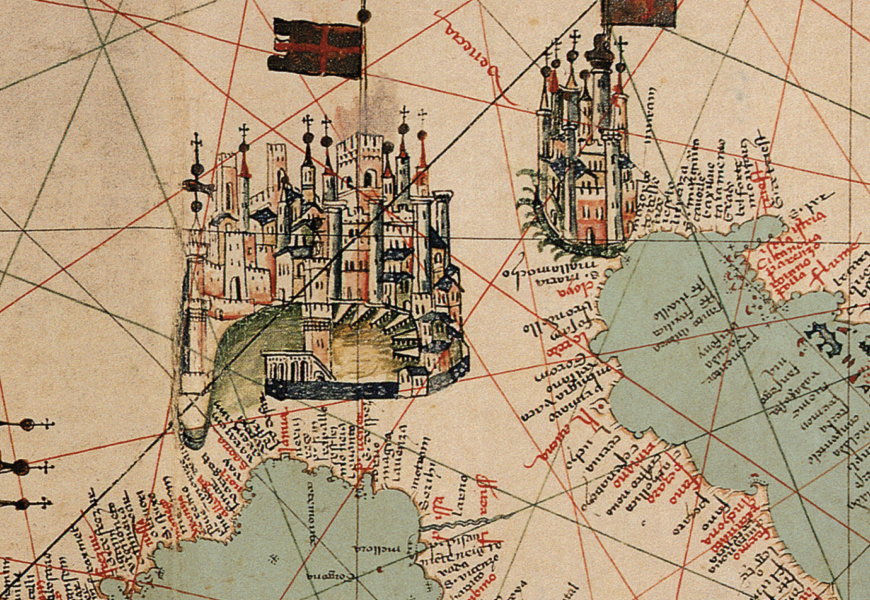Genova, una porta tra mare e monti

In una carta nautica del 1435 Genova si distingue per il bacino portuale, i moli, le due torri faro (Lanterna e Torre dei Greci) e la torre di Palazzo Ducale con la bandiera della città // A nautical chart dated 1435 shows Genoa’s harbour area, the quays, the two lighthouse towers (Lanterna and Torre dei Greci) and the tower of Palazzo Ducale flying the Genoese flag
Il golfo naturale offre poca protezione, ma è il passaggio privilegiato di uomini e merci
Gli Etruschi, nel VII secolo a. C., frequentano per primi queste coste dopo aver imparato dai Greci l’arte della navigazione. Il territorio, schiacciato tra monti e mare, offre solo piccole rade sabbiose dove possono trovare riparo le barche. La nascita del primo insediamento, quello che in seguito prenderà il nome di Ianua, si sviluppa sulla collina (oggi chiamata di Castello), mentre una piccola rientranza viene usata a protezione delle imbarcazioni. I due promontori – che formano l’insenatura dove adesso si trovano il Porto Antico, il porto passeggeri (gli approdi per navi da crociera e traghetti) e il terminal container PSA SECH che vedrete più avanti – non erano in grado di proteggere le acque dai forti venti di Libeccio e di Scirocco. Questa fu fin dagli inizi una delle sfide che gli abitanti di questo piccolo golfo dovettero vincere per garantire alle proprie imbarcazioni sicurezza e riparo.
Con il passare dei secoli, la speciale posizione di Genova, quasi passaggio naturale tra il Mediterraneo, le terre padane e l’Europa, la rende centro indispensabile per i commerci e i contatti col resto del mondo via via conosciuto. ‘Porta’ tra il mare e i monti, dal doppio volto come il dio Giano al quale i Romani indirizzavano i loro culti, Genova forse deve il suo nome antico di Ianua al suo rivolgersi verso due fronti.
L’importanza del luogo e dell’insediamento si accresce nei secoli; non è un caso che nell’802 Carlo Magno riceva in dono dal califfo di Bagdad un elefante giunto per via di terra fino all’Egitto e da lì attraverso il Mediterraneo mediante una flotta appositamente partita da Genova.
Genoa, a gateway between the mountains and the sea.
The natural gulf offered little protection but was the preferred passage for travellers and goods.
The Etruscans, in the 7th century B.C., were the first to visit these coasts after learning the art of navigation from the Greeks. The territory, squeezed between the mountains and the sea, offered only small sandy shores where boats could find shelter. The earliest settlement, which would later be named Ianua, developed on a hill (today called ‘Collina di Castello’), while a small inlet was used for the mooring of vessels. The two headlands – which form the bay where the ‘Porto Antico’ (Old Port), the passenger port (the cruise and ferry terminals) and the PSA SECH container terminal are now located – didn’t provide enough protection from the strong Libeccio and Scirocco winds. From the outset, this was one of the challenges the inhabitants of this small gulf had to overcome to provide protection for their vessels.
Over the centuries, Genoa’s unique position of natural gateway between the Mediterranean, the Po River Valley and Europe, made it a crucial hub for trade and relations with the rest of the world. As a ‘gateway’ between the sea and the mountains, with two faces like the god Janus worshipped by the Romans, Genoa perhaps owes its ancient name of Ianua to its double facing position.
The importance of the site and the settlement grew over the centuries. In fact, in 802 Charlemagne received a special gift from the Caliph of Baghdad: an elephant, transported overland to Egypt and from there across the Mediterranean by a fleet arriving from Genoa.
